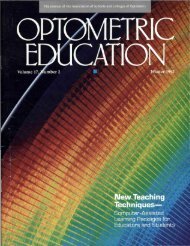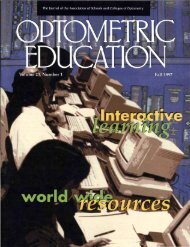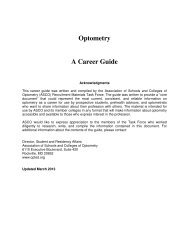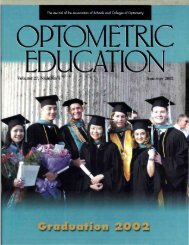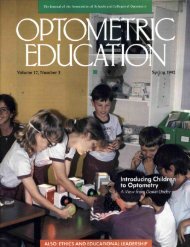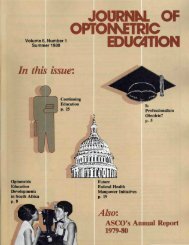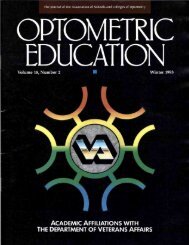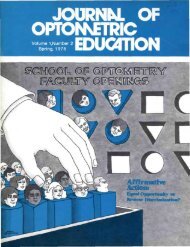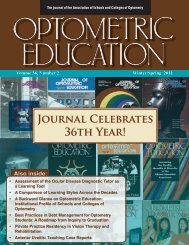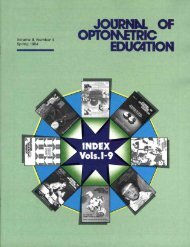JOURNN. OF - Association of Schools and Colleges of Optometry
JOURNN. OF - Association of Schools and Colleges of Optometry
JOURNN. OF - Association of Schools and Colleges of Optometry
Create successful ePaper yourself
Turn your PDF publications into a flip-book with our unique Google optimized e-Paper software.
PART III<br />
Faculty Load Formulas<br />
%Jne can propose a number <strong>of</strong> arguments<br />
for the utility <strong>of</strong> faculty load formula:<br />
the balance <strong>of</strong> activities within an<br />
individual faculty assignment <strong>and</strong><br />
balance <strong>of</strong> assignment between faculty;<br />
the analysis required to assess current<br />
costs or to construct costs for planning;<br />
<strong>and</strong> for accountability in funding. A<br />
number <strong>of</strong> attempts have been made to<br />
develop formulas which take into account<br />
factors directed toward producing<br />
a more precise index as to faculty load.<br />
Moreover, while faculty load formulas<br />
have been promulgated over the years it<br />
seems safe to say that at the college<br />
level no formula for computing faculty<br />
load has enjoyed wide currency over<br />
any long period <strong>of</strong> time nor does any<br />
formula seem to enjoy widespread favor<br />
at present. 34 Health pr<strong>of</strong>essions education<br />
seems to have ignored the subject<br />
altogether. Stickler 34 makes this concluding<br />
statement after reviewing a host<br />
<strong>of</strong> publications on the subject: "... only<br />
one conclusion seems to be fully substantiated:<br />
the total faculty load <strong>of</strong> a college<br />
or university teacher cannot be simply<br />
described nor easily measured."<br />
It seems in this comment lies the key<br />
to the solution. Many studies have oversimplified<br />
the description <strong>of</strong> load, mainly<br />
from limited measures if any measures<br />
at all. The design <strong>of</strong> a load formula<br />
must include those elements generally<br />
perceived as faculty related activity,<br />
take into account appropriate<br />
weighting factors for each, <strong>and</strong> yet remain<br />
sufficiently uncluttered as a formula<br />
that potential users endorse its<br />
use.<br />
The term "faculty load" includes the<br />
sum <strong>of</strong> all activities which take the time<br />
<strong>of</strong> a college or university teacher <strong>and</strong><br />
which are related either directly or indirectly<br />
to his or her pr<strong>of</strong>essional duties,<br />
responsibilities <strong>and</strong> interests. 34 Perhaps<br />
the most common measure <strong>of</strong> faculty<br />
load in institutions <strong>of</strong> higher learning has<br />
been the credit hour—semester or quarter.<br />
A presumption is made that there is<br />
some constant ratio between credit hour<br />
load <strong>and</strong> total faculty load. The discussion<br />
thus far indicates such a measure<br />
lacks completeness in many respects<br />
even though it enjoys common usage.<br />
"Student credit hours" (SCH),<br />
another measure, is determined by multiplying<br />
the credit hours for a course by<br />
the number <strong>of</strong> students in the class. The<br />
sum <strong>of</strong> these figures for all classes taught<br />
gives the total student credit hours generated<br />
for a given teacher. This approach<br />
adds the element <strong>of</strong> class size. It<br />
has been said an average <strong>of</strong> 300 student<br />
credit hours per instructor constitutes a<br />
reasonable norm. 34 This figure has been<br />
used as a reference point in making instructional<br />
cost analyses.<br />
"Student contact hours"—or "teaching<br />
clock hours"—is yet another way <strong>of</strong><br />
measuring class load. This makes allowance<br />
for the extra time spent in courses<br />
as science laboratories. Different types<br />
<strong>of</strong> institutions have shown median load<br />
ranges from 14.4 to 18.2 student contact<br />
hours per week. 34 Junior colleges<br />
tend to exceed this <strong>and</strong> commonly consider<br />
20-25 student contact hours per<br />
week to be a normal workload.<br />
"Total clock hours" worked per week<br />
rather than credit hours or student contact<br />
hours is perhaps the best single index<br />
<strong>of</strong> faculty load; the major advantage<br />
is the inclusion <strong>of</strong> activities such as<br />
research <strong>and</strong> the whole spectrum <strong>of</strong><br />
pr<strong>of</strong>essional services in addition to<br />
teaching <strong>and</strong> its concomitant responsibilities.<br />
Unit Systems<br />
While total clock hours per week may<br />
<strong>of</strong>fer the best single index <strong>of</strong> faculty load<br />
this statement gives little hint as to the<br />
application <strong>of</strong> this approach, especially<br />
when considering faculty load assignment.<br />
Various unit systems have been<br />
proposed as a means <strong>of</strong> dealing with the<br />
elements <strong>of</strong> load in some relative<br />
fashion so as to predict a total clock<br />
hour week from activities assigned.<br />
Such a system was reported by Howell 31<br />
in 1962 pertaining to the Northern Illinois<br />
University. Differing point values<br />
were assigned for factors as undergraduate<br />
work taught, graduate work<br />
taught, each hour taught in extension,<br />
enrollments over a base <strong>of</strong> 30 in each<br />
class, advisees, committee participation,<br />
<strong>and</strong> holding <strong>of</strong>fice in a state or national<br />
organization.<br />
A point system also was developed<br />
for use in the School <strong>of</strong> Nursing, University<br />
<strong>of</strong> Wisconsin-Milwaukee. 3 Utilizing<br />
the three broad categories <strong>of</strong> "teaching,"<br />
"research" <strong>and</strong> "service," point<br />
values were assigned various activities<br />
as a means <strong>of</strong> achieving a relative<br />
weighting.<br />
A comprehensive unit approach was<br />
developed for use at Colorado State<br />
University. 44 Termed the "comparative<br />
staffing unit" (CSU), these units quantified<br />
the direct instructional, related instructional<br />
<strong>and</strong> related pr<strong>of</strong>essional activities<br />
<strong>of</strong> faculty members. The method<br />
measured estimated faculty input taking<br />
into account type <strong>of</strong> course, level <strong>of</strong><br />
course, number <strong>of</strong> students per course<br />
<strong>and</strong> whether courses were initial or<br />
repeat sections. Student advising, committee<br />
assignments <strong>and</strong> related pr<strong>of</strong>essional<br />
activities also specifically were<br />
recognized.<br />
In short, the system allowed for the<br />
identification <strong>and</strong> quantification <strong>of</strong> significant<br />
activities in which faculty members<br />
are involved. A comparative staffing<br />
unit (CSU) is intended to measure<br />
the relative amount <strong>of</strong> pr<strong>of</strong>essional input<br />
necessary to carry out a specific activity.<br />
By definition, a full-time university<br />
instructional faculty position consists <strong>of</strong><br />
1,000 CSUs (1,000 CSUs = 1.0FTE).<br />
For example, should the individual<br />
components <strong>of</strong> a faculty member's<br />
workload add to 1200 CSUs, it would<br />
indicate an overload <strong>of</strong> 20 percent. For<br />
direct instructional activities, the basic<br />
unit <strong>of</strong> instructional workload is defined<br />
as one credit hour <strong>of</strong> lecture in a typical<br />
undergraduate course. Activities requiring<br />
less faculty input are assigned a<br />
lower workload factor; those requiring<br />
more faculty input are assigned a higher<br />
workload factor.<br />
Formulary<br />
The formula approach to measuring<br />
workload has been reported by several<br />
authors in the early 70s. 13 . 45 ' 46 ' 47 ' 48 ' 49<br />
The formulas provide for the inclusion<br />
<strong>of</strong> factors as type <strong>of</strong> course, contact<br />
18 Journal <strong>of</strong> Optometric Education



